"Hyper-active gap-filling" now published
March 22, 2015
Linguistics

Now out in
Frontiers in Psychology: Language Sciences, "
Hyper-active Gap-filling" by
Akira Omaki,
Ellen Lau,
Colin Phillips, and RAs Imogen White, Myles Dakan and Aaron Apple. The paper studies the processing of sentences in verb-medial languages where a wh-object has been fronted. It asks whether comprehenders wait to consult verb transitivity information before constructing filler-gap dependencies, or instead make representational commitments on the gap position before verb transitivity information becomes available. In the latter case, disruption should be observed when the verb is intransitive. In three reading experiments (self-paced and eye-tracking) that manipulated verb transitivity, the authors found evidence for reading disruption when the verb was intransitive, although no such reading difficulty was observed when the critical verb was embedded inside a syntactic island structure, which blocks filler-gap dependency completion. These results are consistent with the hypothesis that in English, as in verb-final languages, information from preverbal NPs is sufficient to trigger active dependency completion without having access to verb transitivity information.



